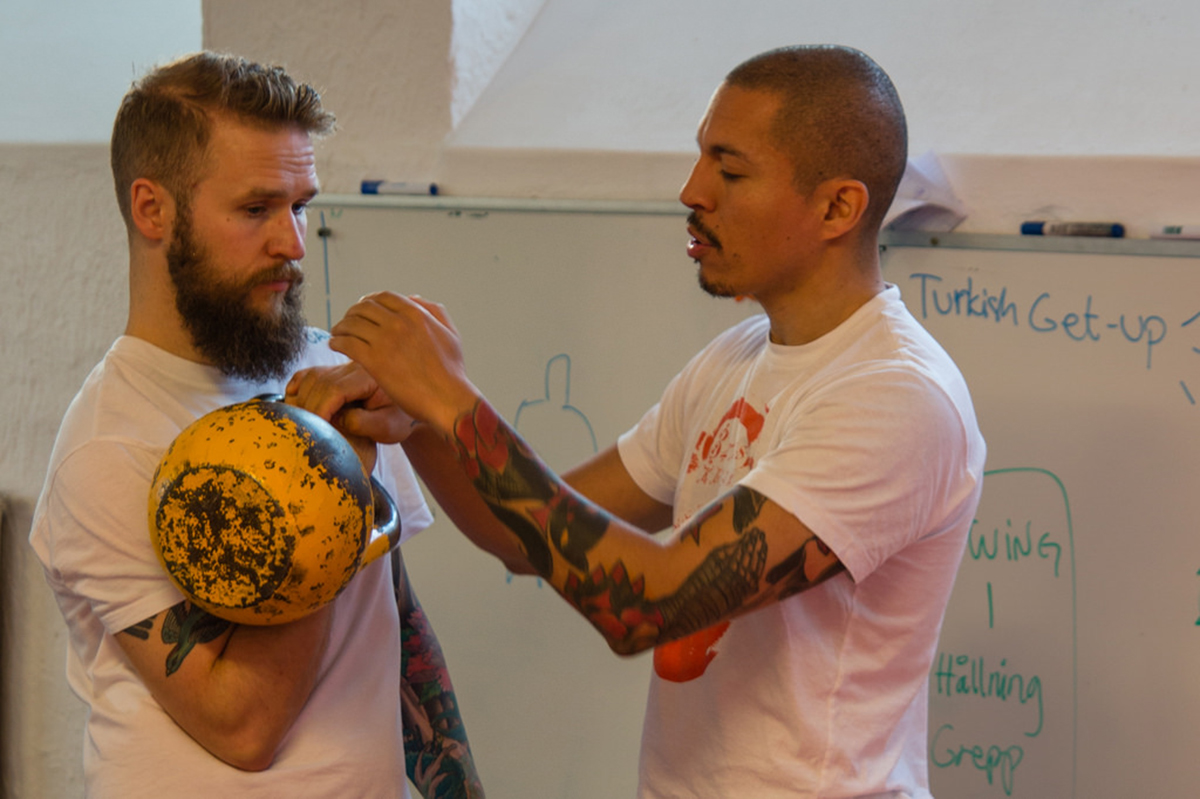Table of Contents
Dragon Flag
The Dragon Flag is a standard gymnastics move for the lats and core. It's one of the progressions for front levers, for instance, and many gymnasts use them as part of a warmup or as a bit of abs work as a finisher. That should go some way to explaining why gymnasts look the way they do! You lie on your back and curl your body up using your lats and core, holding onto something secure with your arms. Or, if you like a challenge, something insecure, like a p[air of kettlebells.
Or you can do it the easy way. Curl your body up until you're doing a tucked shoulder stand, with your coccyx facing directly upend your legs bent. Straighten your legs, hollow your core and slowly lower yourself until your feet are on the floor again, using the kettlebells as a counterweight. Lose points if your feet bang into the floor: try to put them down softly, under control.

Sure you want to know about the hard way? OK...
Start as before. Hollow your core and lift your feet clear of the floor. Now raise your body into the top shoulderstand position without bending your knees or hips, Flexing only at the upper back. Lower and repeat, if you can!
Why Do It? Do one and you'll know. If you can crank these out for reps, and by reps I mean 6-8, typical gym abs exercises will be nothing. You'll have a core like steel.
Rack Walks/Overhead Walks
Basically, it's a weighted carry. But the kettlebell weighted carry isn't going to be heavy enough to really challenge you if you're fit. Rack the bells or press them overhead and try a variety of walks to improve muscle strength and mobility in the hips and shoulders. We'll cover the squat walk.
Squat walks are pretty simple. You normally walk in the top position of a squat, if you think about it: with these, you're walking in the bottom position. rack your bells and squat. Then walk without coming out of the squat! If you're too relaxed in the bottom position, you can feel your muscles turn off and you're in trouble because now you're hanging on your soft tissue structures, which is going to result in injury to knees, ankles or whatever the weakest link is in your personal physique. Stay somewhat tense and pay attention to where your hips are. Want to make it harder? Try stepping sac time until the front leg is fully extended, then transferring your weight to that foot without moving it. Still bored? Put those bells overhead!
Why Do It? Partly because it's metabolically demanding. It's good conditioning. But the main reason is because it makes you do mobility movements under a load, meaning you'll see improvements in your flex and strength straight away — sometimes even in the same session. Loaded mobility movements are by far the best way to teach the Golgi tendon organs what length your muscles are supposed to be. Got tight hips? You came to the right place! Racked walks are the best because if your form goes and your back rounds, you drop a bell. Overhead walks are a massive challenge to hip mobility and shoulder stability at the same time, resulting in improvements in both areas.
Towel Circular Swing
Basically it's a circular swing, using a towel to hold the kettlebell. It makes the kettlebell behave somewhat like an Indian mace, so you can swing it in different patterns. Thin of it as a hack to make two training tools out of one!
Run a(strong!) towel through your kettlebell handle and hold one end of the towel in each hand. Lift your hands overhead. Now, move the kettlebell in a circle around your body until it returns to the front. Reverse. As you get used to the movement, try doing it faster until the kettlebell acquires some momentum and is truly swinging.
Why Do It? When you swing a bell like this, the force is coming at your core from all directions, requiring you to move slightly to accommodate it, but also to resist it. It's a great all-over core and metabolic exercise, but it takes a little skill and some humility. Go slow to start and you'll be surprised by how hard — and effective — it is!
READ Kettlebell Clean And Jerk - For Power, Strength And Endurance
If you'd like more details on any of these, or I missed your favourite, let me know in the comments!
- Photo courtesy of .V1ctor Casale. via Flickr: www.flickr.com/photos/v1ctor/8495391748
- Photo courtesy of .V1ctor Casale. via Flickr: www.flickr.com/photos/v1ctor/8495391748
- Photo courtesy of Viljan Träningsklubb via Flickr: www.flickr.com/photos/viljantraningsklubb/15532779397


Your thoughts on this